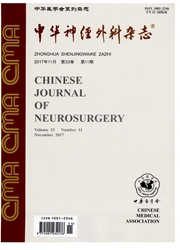

 中文摘要:
中文摘要:
目的对颅内动脉瘤进行三维数值模拟并分类,分析其血流动力学特性。方法联合应用Matlab、Ansys、Fluent等软件及自写程序对39例颅内动脉瘤进行数值模拟。结果两类动脉瘤模型流人道的血流速度、动压及壁面切应力最高,流出道次之,瘤顶部最低;且A类(长宽比〉1.8)动脉瘤破裂率明显高于B类(长宽比≤1.8)。A类动脉瘤流人道侧壁和瘤顶部壁面切应力比值(WSS's ratio)明显大于B类动脉瘤;且与其长宽比成正相关。结论颅内动脉瘤顶部的血流速度、动压及壁面切应力均最低,是其破裂的主要原因和部位。流人道和瘤顶部壁面切应力比值及动脉瘤的长宽比反映动脉瘤的破裂风险,其比值越大,破裂风险越高。
 英文摘要:
英文摘要:
Objective To classify intracranial aneurysms according to ellipticity index (El), simulate the aneurismal models with computational Fluid Dynamic (CFD) softwares and to analyze the hemodynamical features of aneurysms. Method According to El, 39 aneurysms were divided into type A (El 〉 1.8)and type B(EI~〈I. 8) Matlab,Ansys,and Fluent softwares were used to simulate the blood flow of aneurysms. Results The dynamic pressure, velocity and wall shear stress on the top of the aneurismal models were the lowest. The parameters near the "inflow tract" were the highest. The rupture risk of type A aneurysms were higher than that of type B. The WSS's ratio of type A was positive correlation with the EI. Conclusions The hemodymamic factors, such as dynamic pressure, velocity and wall shear stress, are the lowest on the top of aneurysm, which contribute to its rupture. The rupture risk of aneurysms can be reflected by EI and WSS's ratio in the inflow tract and the top of the aneurysms. Following the increasing of El and WSS's ratio, the rupture risk of aneurysms is increasing too.
 同期刊论文项目
同期刊论文项目
 同项目期刊论文
同项目期刊论文
 The effect of aneurismal-wall mechanical properties on patient-specific hemodynamic simulations: two
The effect of aneurismal-wall mechanical properties on patient-specific hemodynamic simulations: two 期刊信息
期刊信息
